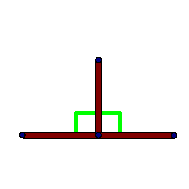Right angle (geometry): Difference between revisions
Jump to navigation
Jump to search

imported>Bruce M. Tindall mNo edit summary |
mNo edit summary |
||
| Line 12: | Line 12: | ||
and so is angle ABD | and so is angle ABD | ||
The plus sign, +, consists of two such lines, and so the four angles at its heart are all right angles. | The plus sign, +, consists of two such lines, and so the four angles at its heart are all right angles.[[Category:Suggestion Bot Tag]] | ||
Latest revision as of 11:00, 12 October 2024
In Euclidean geometry, a right angle, symbolized by the L-shaped figure ∟, bisects the angle of the line into two equal parts. The right angle is created when two straight lines meet perpendicularly at 90 degrees to each other.
The right angle is demonstrated:
Given a line DC with point B lying on it Project a line from B through point A Take B as the vertex of angle ABC If the angle ABC equals the angle ABD then angle ABC is a right angle, and so is angle ABD
The plus sign, +, consists of two such lines, and so the four angles at its heart are all right angles.
